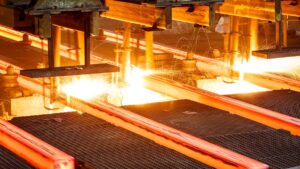Steel could go green by 2050 and it will only cost US$278 billion to get there: BNEF

Pic: EmptyStories/ iStock/ Getty Images Plus
Research house BloombergNEF says US$278 billion (A$390bn) of additional investment could see the industry make steel with almost no carbon emissions by 2050.
BloombergNEF launched a new report today called Decarbonizing Steel: A Net-Zero Pathway, which claims a combination of falling hydrogen costs, cheap clean power, and increased recycling could reduce emissions to net zero while production rises.
Around 70% of steel is currently made in coal-fired blast furnaces, with about 60% of the market located in China.
Report authors say investments now in gas-fired direct reduced iron mills which could be retrofitted to take green hydrogen could reshape the market and prepare those plants for conversion into green steelmakers.
BNEF estimates by 2050, green hydrogen fired DRI could be the cheapest portion of the steel sector with a 31% market share.
45% of the market could come from recycled scrap in electric arc furnaces with the balance provided by coal-fired plants fitted with carbon capture systems and innovative processes using electricity to refine iron ore into iron and steel.
Industry must move now: BNEF
Echoing the sentiments of iron ore billionaire turned green energy advocate Andrew Forrest, BNEF head of sustainable materials Julia Attwood said work needed to start now to begin the energy transition in the steel industry, which produces upwards of 7% of greenhouse gas emissions.
“The steel industry cannot afford to wait for the 2040s to start its transition,” said Julia Attwood, head of sustainable materials at BNEF and lead author of the report.
“The next ten years could see a massive expansion of steel capacity to meet demand in growing economies, such as India.”
She said building new coal-fired steel factories would leave businesses in the lurch by the middle of this century.
China, home to 57% of the world’s steel production, has set a 2060 date to get to net zero and the steel industry could hit peak steel emissions by 2025.
“Today’s new plants are tomorrow’s retrofits. Commissioning natural gas-fired plants could set producers up to have some of the lowest-cost capacity by retrofitting them to burn hydrogen in the 2030s and 2040s,” Attwood said.
“But continuing to build new coal-fired plants will leave producers with only bad options toward a net-zero future by 2050.”
Could green steel kill Australia’s golden goose?
One of the hallmarks of green steel production will be the need for high grade iron ore as a feedstock.
For that reason BNEF believes places with abundant clean power and high grade iron ore reserves like Russia, India, Brazil and South Africa could benefit from the shift.
Australia, where many of the Pilbara miners deliver iron ore below benchmark 62% grades, could find itself under pressure to transition to higher grade ore sources like magnetite concentrates.
“Brazil is expected to have one of the lowest costs for hydrogen production by 2030, according to research by BloombergNEF,” BNEF said.
“South Africa and India have good iron ore reserves and the potential to produce a large amount of low-cost clean power.
“The world’s largest iron ore producer, Australia, however, currently produces lower grade ores, and could lose its number one place in the supply chain, if it does not invest in equipment to upgrade its product.”
Within Australia majors Fortescue (ASX:FMG), Mineral Resources (ASX:MIN) and Hancock Prospecting are building or studying high grade magnetite projects like FMG’s Iron Bridge mine.
Junior iron companies are also operating in that space, expecting to leverage growth in the market for high-grade iron ore from the decarbonisation of the sector.
They include ASX-listed companies like Magnetite Mines (ASX:MGT), Hawsons Iron (ASX:HIO) and Grange Resources (ASX:GRR).
The scale of the changes ahead
BNEF’s head of industrial decarbonisation Kobad Bhavnagri says companies and investors do not yet understand the scale of the changes ahead.
“The global steel industry is poised to begin a titanic pivot from coal to hydrogen,” he said.
“Green hydrogen is both the cheapest and most practical way to make green steel, once recycling levels are ramped up. This transition will cause both great disruption, and great opportunity.”
BNEF thinks new clean steel capacity and retrofits to existing technology will cost the steel sector US$278 billion compared to business as usual growth capital.
This compares to the mammoth US$172 trillion needed to decarbonise the global energy sector.
They believe most of the costs will come not from capital, but operations, making the cost of green hydrogen essential to the transition.
BNEF says green hydrogen could fall more than 80% by 2050 to under US$1/kg, while recycled steel production, which makes up about 25% of the market globally at the moment, would require a 5% premium to match costs for today’s production.
As green power costs fall, this could reduce to under 1%.
Related Topics
UNLOCK INSIGHTS
Discover the untold stories of emerging ASX stocks.
Daily news and expert analysis, it's free to subscribe.
By proceeding, you confirm you understand that we handle personal information in accordance with our Privacy Policy.








